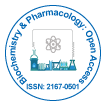
Biochemistry & Pharmacology: Open Access
Open Access
ISSN: 2167-0501

ISSN: 2167-0501
Commentary Article - (2025)Volume 14, Issue 1
Cancer treatment has seen remarkable progress in recent decades, largely due to advancements in targeted therapies, immunotherapies, and chemotherapeutic regimens. Despite these strides, drug resistance continues to be a formidable barrier to successful long-term cancer management. Both intrinsic and acquired resistance mechanisms compromise therapeutic efficacy, often resulting in tumor relapse or progression. At the heart of these resistance pathways lie intricate molecular changes ranging from genetic mutations to alterations in the tumor microenvironment that enable malignant cells to survive, adapt, and proliferate in the presence of therapeutic agents.
Genetic mutations in oncogenes and tumor suppressor genes are well-established contributors to drug resistance. For instance, mutations in the BCR-ABL gene in chronic myeloid leukemia confer resistance to imatinib, one of the first successful targeted therapies. Similarly, secondary mutations in the EGFR gene in non-small cell lung cancer patients render them less responsive to tyrosine kinase inhibitors such as erlotinib and gefitinib. These mutations often result in structural changes that reduce drug binding affinity or activate alternative signaling cascades, thereby bypassing the inhibited pathway.
Beyond genetic alterations, epigenetic changes also play a vital role in drug resistance. DNA methylation, histone modifications, and non-coding RNAs have all been implicated in the modulation of genes related to drug metabolism, apoptosis, and DNA repair. For example, the hypermethylation of promoter regions of tumor suppressor genes can silence their expression, promoting cell survival despite drug exposure. Additionally, the overexpression of efflux transporters such as P-glycoprotein (P-gp) actively pumps out drugs from cancer cells, significantly lowering intracellular drug concentrations and diminishing therapeutic impact.
The tumor microenvironment is another critical player in the development of drug resistance. It comprises a complex network of stromal cells, immune cells, blood vessels, and extracellular matrix components, all of which interact with tumor cells to influence their behavior. Cancer-associated fibroblasts, for instance, can secrete growth factors and cytokines that support tumor growth and survival. Hypoxia within the TME can induce the expression of hypoxia-inducible factors (HIFs), which in turn activate genes involved in angiogenesis, metabolism, and survival pathways. These adaptations enable cancer cells to persist under adverse conditions, including those induced by chemotherapy or targeted agents.
Moreover, the phenomenon of Epithelial-Mesenchymal Transition (EMT) has garnered significant attention for its role in promoting drug resistance and metastasis. EMT endows epithelial cancer cells with mesenchymal features, enhancing their motility, invasiveness, and resistance to apoptosis. EMT is driven by transcription factors such as Snail, Slug, and Twist, which suppress epithelial markers and upregulate mesenchymal proteins. These cellular transformations not only facilitate evasion from therapeutic agents but also complicate treatment by contributing to tumor heterogeneity.
Cancer stem cells (CSCs) represent another subpopulation associated with resistance. These cells possess the unique ability to self-renew and differentiate, making them inherently resistant to conventional therapies aimed at rapidly dividing cells. CSCs often reside in protective niches within the tumor and express high levels of drug efflux pumps, anti-apoptotic proteins, and DNA repair enzymes. Their persistence post-therapy can lead to tumor regeneration and relapse, underscoring the need for CSC-specific therapeutic strategies.
Understanding these diverse molecular mechanisms is vital for developing more effective therapeutic interventions. Novel approaches such as combination therapies, which target multiple pathways simultaneously, have shown promise in overcoming resistance. For instance, combining TKIs with inhibitors of downstream signaling molecules or immune checkpoint inhibitors can counteract resistance mechanisms and restore drug sensitivity. Furthermore, advances in genomics and proteomics enable real-time monitoring of tumor evolution, allowing for personalized treatment adjustments based on the resistance profile of the tumor.
In conclusion, drug resistance in oncology is a multifaceted challenge driven by genetic, epigenetic, cellular, and microenvironmental factors. A comprehensive understanding of these mechanisms is essential to design therapeutic strategies that can either prevent the emergence of resistance or effectively counteract it. Continued research integrating molecular biology, genomics, and clinical pharmacology is crucial to uncover novel targets and biomarkers for resistance, ultimately leading to more durable and effective cancer treatments. By elucidating these complex resistance pathways, we move closer to the goal of truly personalized oncology therapeutics that can adapt in real time to the ever-changing nature of cancer.
Citation: Kohler A (2025). Elucidating the Molecular Mechanisms Underlying Drug Resistance in Oncology Therapeutics. Biochem Pharmacol. 14:384.
Received: 03-Feb-2025, Manuscript No. BCPC-25-37576 ; Editor assigned: 05-Feb-2025, Pre QC No. BCPC-25-37576 (PQ); Reviewed: 19-Feb-2025, QC No. BCPC-25-37576 ; Revised: 26-Feb-2025, Manuscript No. BCPC-25-37576 (R); Published: 04-Mar-2025 , DOI: 10.35248/2167-0501.25.14.384
Copyright: © 2025 Kohler A. This is an open-accessarticle distributed under the terms of the Creative Commons Attribution License, which permits unrestricted use, distribution, and reproduction in any medium, provided the original author and source are credited.